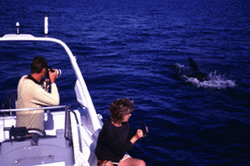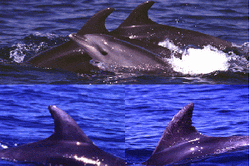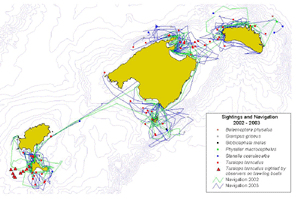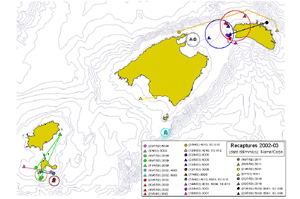Aims:
The goal of this study was to develop an Action Plan for the Conservation
of the Bottlenose Dolphin (Tursiops truncates) in the Balearic Islands.
To this end three main specific priorities were identified in the proposal.
(1) to determine the number of Bottlenose dolphins present in each area,
(2) to establish the degree of isolation and the demographic evolution
of the different groups, and (3) to evaluate the impact of fishing and
other threatening factors in the main areas.
Methods applied:
Two different methodologies were used: aerial census count and photo-identification.
Establishing number of animals.
Aerial census count.
In order to evaluate the populations of common dolphin (Action F7) and
of Loggerhead turtle (Action F6), three different flight campaigns were
carried out during which the whole of the continental seaboard of the
Balearic Archipelago was covered. An area of 2,780.54 nautical miles was
covered which yielded sightings of a total of 18 Bottlenose dolphins ,
although other species of cetaceans were also sighted. During the sightings
which occurred in the photo-identification campaign, the duration of immersions
and the breathing rhythms of the dolphin groups were recorded in order
to carry out any necessary corrections of the aerial census counts.

Figure 7.1:
Photo-identification (marking/re-capture)
Photo-identification is a process in which an animal is photographed and
identified in order to differentiate it from other individuals of its
species by examining the photographs and detecting the presence of marks
(generally natural) on its body. In the case of dolphins, the body marks
used to identify and differentiate individuals are situated on the dorsal
fin.
Four sighting and photo-identification campaigns were carried out in the
Balearic Archipelago: during the months of June, July and September 2002,
from the middle of March to the middle of July of 2003, from the middle
of March to the end of June 2004 and in March 2005. In order to estimate
the size of the population by means of photo-identification we used the
MARK v.4.1 programme for the application of marking-recapturing, developed
in 1999 by White and Burnham (Colorado State University).
 |
 |
Figure
7.2: |
Figure 7.3: |
Degree of isolation and demographic evolution.
Establishing local movements and the degree of isolation of the various
sub-populations in the Balearic Islands was done by analysing the data
obtained by means of photo-identification. Furthermore skin and fat samples
from both live and beached dolphins were analysed in order to determine
their content and profile of organochloride compounds, stable isotopes
and genetic profile. The results obtained were compared to those existing
on other populations of Bottlenose dolphins in both the Atlantic and Mediterranean,
in order to establish the degree of isolation of the Balearic population
of this animal.
The effects of fishing and other threatening factors.
Fishing poses a serious threat in terms of incidental mortality / capture,
and in terms of direct attacks by fishermen who view dolphins as direct
competitors that damage their nets and reduce the volume of their catch
of fish. Three hundred questionnaires were filled by fishermen and ships
were boarded and travelled on in 200 instances in order to evaluate the
problems derived from the interaction of fishing activities and dolphins.
Further to this, an acoustic detection device was used (Porpoise Detector
or POD). This is a small submersible computer attached to a hydrophone
which detects the presence of dolphins and their interaction with the
nets. The POD used was built by Chelonia-Marine Conservation Research,
UK, and was used to evaluate the interaction in those fishing activities
which the first studies revealed were the most endangering for cetaceans
: the trammel nets employed for fishing red-mullet (Mullus surmuletus)
and cuttlefish (Sepia officinalis). The evaluation was carried out in
the Bay of Alcudia in September and October 2001 in relation to the fishing
of red-mullet and in Ciudadela in the months of February and March 2002
in relation to the fishing of cuttlefish.
The level of contaminating organochloride compounds found
in the tissues of Bottlenose dolphins was also determined by means of
analysing the biopsies obtained from live animals as well as the tissues
obtained from dead beached dolphins. The samples were analysed by gas
chromatography and detection of electronic capture.
Involvement of sports clubs and environmental education.
ANADE , the Association of Nautical Sport Installation in the Balearics
(Asociación de Instalaciones Náutico Deportivas de Baleares),
and the General Port Authority of the Balearics (Dirección General
de Puertos de las Islas Baleares) offered their collaboration in order
to organize educational lectures on the environment, related to the project.
Thus, a series of lectures were planned and given at major yacht clubs
and marinas round the Archipelago in order to publicize the aims of the
project, informing seafarers on the various species of cetaceans that
are found round the Balearic Archipelago, so as to get people involved
and encourage seafarers to participate in collecting data on sightings
by means of photography. These lectures were supplemented with sighting
files issued to seafarers so that they could fill them in thereby
facilitating the collection of data and the identification of the species
that could be present in the area. The file is available in *pdf. Format
to all interested parties at the project website. Thanks to this initiative
the written press took notice and this helped to further publicize the
project.
Results
Determining the number of individuals
Aerial census count
From the data collected it can be inferred that the population is probably
open permitting the interchange of island groups with groups of the mainland
coast; and that the abundance of Bottlenose dolphins varied between 727
(CV=0,47) in spring and 1,333 (CV=0,44) in autumn.
Photo-identification
In total 12,478 km. were covered, which yielded 142 sightings of the following
species:
Fin Whale--Balaenoptera physalus-(2), Sperm Whale--Physeter macrocephalus-(1),
Long-finned Pilot Whale--Globicephala melas-(1), Risso’s Dolphin--Grampus
griseus-(8), Striped Dolphin--Stenella coeruleoalba-(17), and Bottlenose
Dolphin--Tursiops truncates-(113). (See Figure F-7.2 and Table F-7.3,
annex F7.doc).
After discarding low-quality or repetitive images, the photo-identification
effort yielded a total of 5,208 slides which were catalogued. The detailed
analysis of all these images was added to a catalogue which includes 252
individuals identified thanks to their natural markings. Of these individuals,
100 were re-captured (identified on different days). Intense interaction
with trawlers has been detected, and a total of 95 dolphins were identified
interacting with trawling ships, on at least one occasion. For the whole
of the areas covered during the three photo-identification campaigns carried
out, an estimation was obtained of Ntotal=700 dolphins (Var Ntotal=490).

Figure 7.4
Degree of isolation and demographic evolution
The analysis of the images taken during the photo-identification campaigns
shows that the composition and size of the various groups is not stable
but rather changes frequently which indicates that this population is
characterised by a fission-fusion model, in exactly the same way as happens
in other populations of this species round the globe. Besides this, evidence
has been found indicating that individuals are highly faithful to the
areas they inhabit although in some cases movement between Majorca and
Minorca was detected. The analysis of organochloride compounds and stable
isotopes confirmed the differences between Iberian, Atlantic and Mediterranean
populations. In contrast we were not able to establish a clear difference
between animals in the archipelago and those along the mainland coast
in terms of stable isotopes. Only slight differences in terms of organochloride
compounds were found, and we therefore deduce there is light segregation
between both communities with a probable degree of interchange of individuals.
It has, however, been established that the population in the Mediterranean
is in fact isolated from that in the Atlantic, where two sub-populations
have been identified: one along the coastline and the other pelagic, the
latter being nearer in evolutionary terms to the Mediterranean population.

Figure 7.5
Effect of fishing and other threatening factors.
It has been determined that the most intense interaction takes place with
trammel nets, specially during the cuttlefish and red-mullet seasons,
and that dolphins seriously damage the nets thereby causing loss of income
for the fishermen, and on occasion there are incidental captures when
a dolphin is trapped in the nets. A high degree of interaction with trawlers
was also observed, although in this case the nets are not damaged and
there are no incidental captures.
The analysis of organochloride compounds indicated that the concentration
of fat in the Bottlenose dolphin is very high and exceeds the limits generally
considered as safe. The explanation of this can be found in the high levels
of pollution in the western Mediterranean, which in the case of the Bottlenose
dolphin is even worse given that these animals tend to swim near the coastline
and are predators. It is a known fact that some of the contaminants alter
the reproductive and growth mechanisms of marine mammals and depress their
immune system. Because of this it is strongly recommended that efforts
should be undertaken to reduce the emission of persistent contaminating
products.
Overall results of the Action:
An Action Plan for the
Conservation of the Bottlenose dolphin in the Balearic Islands has
been drawn up, thus fulfilling the aim of this action. Questions posed
at the beginning of this Action have been answered: (1) the size of the
population has been estimated using two different methodologies (aerial
sectioning and photo-identification); (2) the differences between the
Iberian, the Atlantic and the Mediterranean populations have been determined
on the basis of the analysis of organochloride compounds and stable isotopes,
thereby establishing that there is slight segregation between animals
inhabiting the Balearic Archipelago and those inhabiting coastal waters
along the mainland; (3) it has been established that the composition and
size of the groups changes frequently, and that this population is characterised
by a fission-fusion model; (4) evidence has been found indicating that
the animals are highly faithful to the areas they inhabit, although on
occasion movement between Majorca and Minorca has been detected. (5) it
has been shown that the most intense interaction with fishing activity
is in relation to trammel nets, specially during the cuttlefish and
red-mullet seasons, and that this interaction seriously damages the nets,
causes loss of income to the fishermen and on occasion there are incidental
captures; (6) for this species , in Mediterranean waters, high levels
of organochloride compounds and heavy metals have been found, over and
above the level considered as safe; finally, (7) Educational lectures
on environmental matters have been given and the project has been publicized,
furthermore, sighting files have been issued at all main yacht clubs and
marinas in order to involve yachts in the project.
Benefits for SCI areas and/or the species.
The study carried out has furnished us with knowledge on the state of
the population of Bottlenose dolphin that we previously did not have.
It has also made it possible to develop an Action Plan for the conservation
of this species, which includes specific recommendations to be included
in future actions.
Due to that fact that areas marked out as SCI are not very extensive they
are not very useful in terms of dolphin conservation, for as it has been
explained above, although these animals prefer to remain faithful to their
accustomed habitat, they do in fact travel over large areas. Nevertheless,
in some places, as is the case of the Archipelago of Cabrera and the Bays
of Alcudia and Pollensa, the existence of SCI areas is fundamental for
the conservation of the species.
The results of the present project have provided us with hitherto unknown
data which will be useful as reference for future studies that should
be periodically carried out in order to correctly monitor how the population
of Bottlenose dolphin is evolving in the Balearic Archipelago. The Action
Plan for the Conservation of this species in Balearic waters included
the diverse action that should be taken into account in future initiatives.